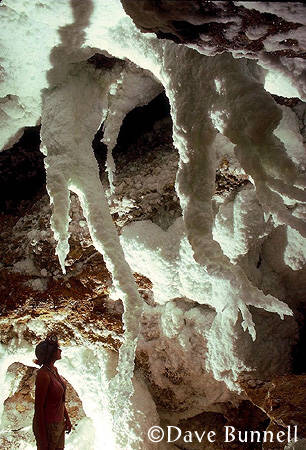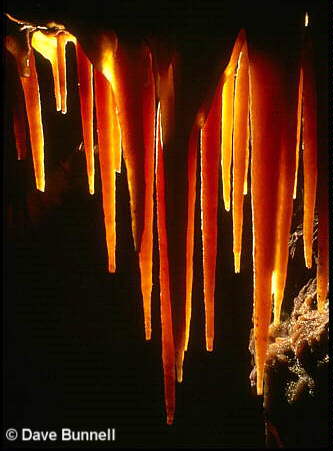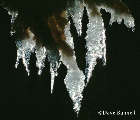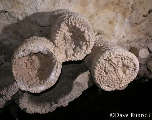
|
Most anyone that's ever heard of caves knows what stalactites are, even if
they can't keep them straight from stalagmites. (Some useful associations are that stalactites
hang "tite" while stalagmites hold "mite", or that stalactites are on the
ceiling, stalagmites on the
ground.) The following photos, however, show something that most people
probably haven't thought about: the birth of stalactites. Actually it's more a coming
of age, the natural evolution of a special type of stalactite: the soda straw.
Crystals of calcite in a soda straw are oriented longitudinally and grow downward, so lengthening the straw. Most soda straws, however, eventually conduct water along their external surface, as well, and there deposit radially oriented calcite crystals perpendicular to their outer surface. This leads to thickening of the soda straw into the classical "icicle" shape most people associate with stalactites. Internal flow may continue, but often ceases as external growth envelopes the former drip canal. The top photo illustrates this critical "adolescent" stage in the development of stalactites. Stalactites come in a variety of forms, some of which have their own classification, such as deflected stalactites. Another much rarer form is the elephant's foot stalactite, which is flat, rather than pointed, on the bottom. An image of these is in the lower table, second image from the left.. Stalactites also form in other minerals such as gypsum (bottom left photo) or epsomite (first image on left in the bottom table), and can look very different from calcite stalactites. |
![]()


 |
 |
 |
 |
 |
 |
Click on a thumbnail to view other images of stalactites.
![]()
Here's an interesting link to a page on growing your own
stalactites from salt solutions
| Back to: | |
 |
Created: June 19, 1995 Last Updated: December 18, 2012 Author: Djuna Bewley |